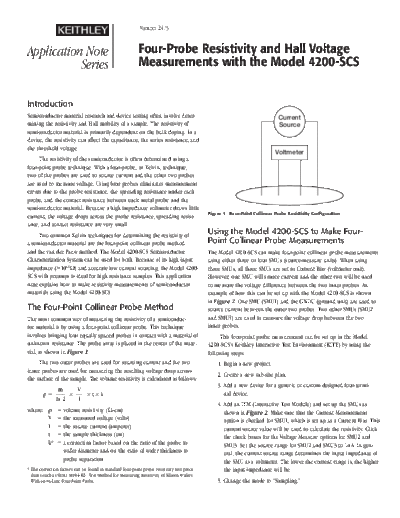Service Manuals, User Guides, Schematic Diagrams or docs for : Keithley SCS 4200 FourProbe Resistivity W4200AppNote
<< Back | HomeMost service manuals and schematics are PDF files, so You will need Adobre Acrobat Reader to view : Acrobat Download Some of the files are DjVu format. Readers and resources available here : DjVu Resources
For the compressed files, most common are zip and rar. Please, extract files with Your favorite compression software ( WinZip, WinRAR ... ) before viewing. If a document has multiple parts, You should download all, before extracting.
Good luck. Repair on Your own risk. Make sure You know what You are doing.
Image preview - the first page of the document

>> Download FourProbe Resistivity W4200AppNote documenatation <<
Text preview - extract from the document
Number 2475
Application Note Four-Probe Resistivity and Hall Voltage
Series Measurements with the Model 4200-SCS
Introduction
Semiconductor material research and device testing often involve deter- Current
mining the resistivity and Hall mobility of a sample. The resistivity of Source
semiconductor material is primarily dependent on the bulk doping. In a
device, the resistivity can affect the capacitance, the series resistance, and
the threshold voltage.
Voltmeter
The resistivity of the semiconductor is often determined using a
four-point probe technique. With a four-probe, or Kelvin, technique,
two of the probes are used to source current and the other two probes
are used to measure voltage. Using four probes eliminates measurement
errors due to the probe resistance, the spreading resistance under each
probe, and the contact resistance between each metal probe and the
semiconductor material. Because a high impedance voltmeter draws little
Figure 1. Four-Point Collinear Probe Resistivity Configuration
current, the voltage drops across the probe resistance, spreading resist-
ance, and contact resistance are very small.
Two common Kelvin techniques for determining the resistivity of Using the Model 4200-SCS to Make Four-
a semiconductor material are the four-point collinear probe method Point Collinear Probe Measurements
and the van der Pauw method. The Model 4200-SCS Semiconductor The Model 4200-SCS can make four-point collinear probe measurements
Characterization System can be used for both. Because of its high input using either three or four SMUs (source-measure units). When using
impedance (>1016W) and accurate low current sourcing, the Model 4200- three SMUs, all three SMUs are set to Current Bias (voltmeter unit).
SCS with preamps is ideal for high resistance samples. This application However, one SMU will source current and the other two will be used
note explains how to make resistivity measurements of semiconductor to measure the voltage difference between the two inner probes. An
materials using the Model 4200-SCS. example of how this can be set up with the Model 4200-SCS is shown
in Figure 2. One SMU (SMU1) and the GNDU (ground unit) are used to
The Four-Point Collinear Probe Method source current between the outer two probes. Two other SMUs (SMU2
The most common way of measuring the resistivity of a semiconduc- and SMU3) are used to measure the voltage drop between the two
tor material is by using a four-point collinear probe. This technique inner probes.
involves bringing four equally spaced probes in contact with a material of This four-point probe measurement can be set up in the Model
unknown resistance. The probe array is placed in the center of the mate- 4200-SCS's Keithley Interactive Test Environment (KITE) by using the
rial, as shown in Figure 1. following steps:
The two outer probes are used for sourcing current and the two 1. Begin a new project.
inner probes are used for measuring the resulting voltage drop across
2. Create a new sub-site plan.
the surface of the sample. The volume resistivity is calculated as follows:
3. Add a new device for a generic or custom-designed four-termi-
V
= ___ ◦ Jabse Service Manual Search 2024 ◦ Jabse Pravopis ◦ onTap.bg ◦ Other service manual resources online : Fixya ◦ eServiceinfo